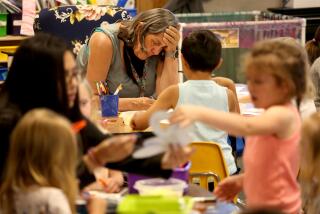Blind Boy Needs Braille Translator for Schoolwork : Education: Woman who was helping him has left Conejo Valley district. Sixth-grader is in regular class.
- Share via
After years of attending schools and programs for the blind in cities as far away as Fremont, Jim Rosso finally is sitting in a regular classroom, learning subjects such as history and English with other Thousand Oaks children.
Jim, a completely blind sixth-grader at Colina Middle School, raises his hand, answers questions and turns in projects and homework, just like sighted students.
Until recently, his progress was made possible by the assistance of a school aide who knew Braille and could translate notes and books for Jim, who is still learning the tactile language.
But the aide, who is credentialed to teach, has recently left the Conejo Valley Unified School District for a higher-paying teaching job, leaving Jim’s parents, teachers and district officials searching for another aide who knows Braille and can help Jim in class.
“I’ve been beating the bushes, looking for someone who knows Braille,” said Jim’s mother, Robin Rosso, who has put out the word at several organizations for the blind that she needs a Braille aide.
District officials acknowledge that it’s tough to find someone who is willing to take a job making between $8 and $10 per hour--the normal pay for a school aide--to do work that requires such skill.
“These people are few and far between,” said Jack Bannon, director of the district’s special education department. “It’s a rare skill.”
Bannon said many of those who know Braille go on to get teaching credentials so that they can pursue higher-paying careers.
Another hurdle, he said, is that in the past, Braille aides often have been elderly men and women who would volunteer in the schools to help blind children. As those volunteers have become too old or sick to teach, they have not been replaced by younger volunteers.
The lack of Braille aides, coupled with a trend toward integrating disabled children into regular classrooms, is leaving many districts without enough support for blind children.
In the Los Angeles Unified School District, the need for aides who know Braille has pushed their hourly rate to between $13 and $16. The Simi Valley Unified School District, like many other districts including Conejo, has a credentialed teacher for the visually impaired whom it shares with other districts.
But it has only two aides who know Braille, and they work with the district’s two completely blind children. Aaron Glaser, the district’s teacher of the visually impaired, said he was in a bind last year when one of those aides was unavailable for a brief time.
“It really left the district scrambling,” he said. “It’s difficult to find people who know Braille.”
In many cases, children who are partly, or even legally blind, can be integrated into classrooms by using large print books and papers and other low-vision techniques. But those who are completely blind like Jim must rely on Braille, which takes several years for young children to learn.
Until she finds an aide who knows Braille, Jim’s mother must read homework and books to her son so that he can keep up in class. The district has a machine that transcribes Braille, but it is at the district office so the process takes a couple of days. The district also has assigned another aide, who is blind, to work occasionally with Jim.
Jim said he is getting along fine, but looks forward to getting an aide who can translate notes into Braille while sitting beside him in class.
“It would be easier if she could help me when I have trouble with my contractions,” said Jim, referring to the basic elements of the Braille language. “It’s a tough thing to learn.” But once Jim learns how to transcribe his own notes in Braille, he will no longer need an aide to help him translate. Then he can be integrated into the classroom with relatively little trouble, a move that many education experts say is good for blind children and the other students in class.
Colina teacher Carol Phillips said that integrating Jim into the class also teaches students tolerance. Several have expressed an interest in making books on tape for Jim. During many of the lessons, she has students describe the pictures in books or the actions in class.
“Without realizing it, they appreciate a little bit more what they see,” Phillips said. “When they describe for Jim, they notice little details that they might not see.”
More to Read
Sign up for Essential California
The most important California stories and recommendations in your inbox every morning.
You may occasionally receive promotional content from the Los Angeles Times.













